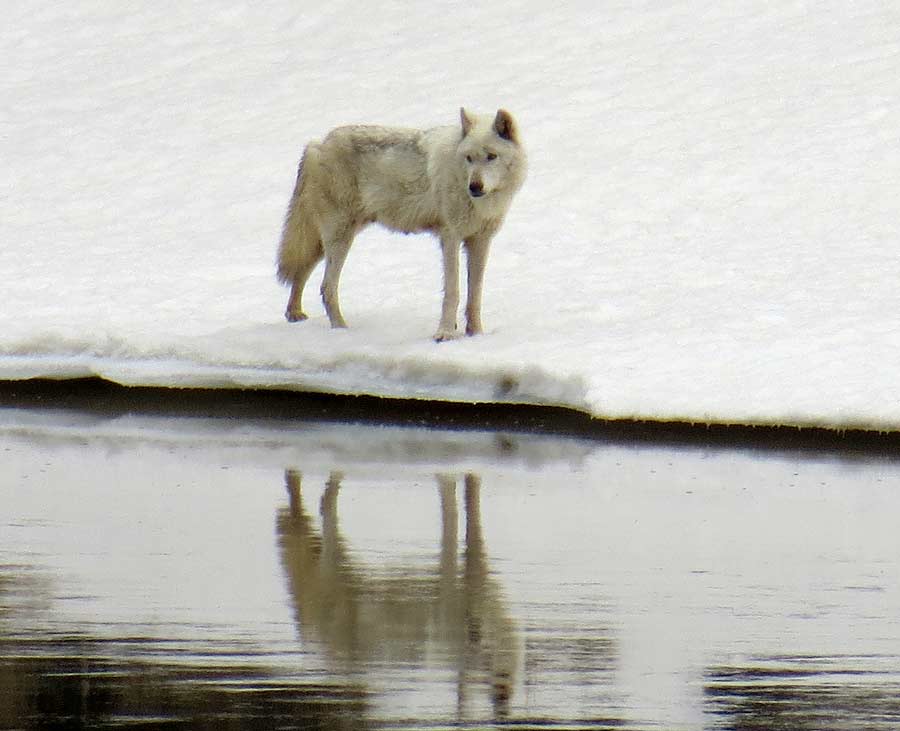
A wolf gazes across the Yellowstone River in Yellowstone National Park. (photo ©Bob Richard)
By Ruffin Prevost
CODY, WYO. — Federal wildlife officials on Friday moved to permanently shift responsibility for managing gray wolves to the states, proposing removal of the animals from the list of threatened and endangered species.
The U.S. Fish and Wildlife Service said the proposal comes after a comprehensive review has confirmed the successful recovery of gray wolves in the Western Great Lakes and Northern Rocky Mountains.
“An exhaustive review of the latest scientific and taxonomic information shows that we have accomplished that goal with the gray wolf,” said USFWS Director Dan Ashe in a statement released by the agency.
“After years of hard work by the states and our federal partners, I am pleased that wolves are ready to stand on their own under the management of state professional wildlife biologists,” Wyoming Governor Matt Mead said.
The move will be welcome news to many ranchers and hunters around the greater Yellowstone area, many of whom say wolf numbers in the region have remained above recovery goals for several years.
“The restoration of the gray wolf is a conservation success story, and the federal government made the right decision in delisting the species,” said Whit Fosburgh, president of the Theodore Roosevelt Conservation Partnership, a hunting and fishing advocacy group.
Fosburgh said in a statement released Friday that the decision to end protections “is based in sound science and achieves long-term goals for wolf management.”
Wolf advocates have argued against relaxing protections for wolves, and condemned state-managed wolf hunting and trapping around the outskirts of Yellowstone National Park.
Noah Greenwald, endangered species director with the Center for Biological Diversity, said the proposed delisting was a “national disgrace.”
“This is like kicking a patient out of the hospital when they’re still attached to life support,” Greenwald said in a statement released Friday.
Wolf advocates say that state management will not allow packs to expand their range beyond a recovery area near Yellowstone and Grand Teton national parks, hindering or scuttling any return of wolves to California or the Pacific Northwest.
Federal wildlife officials say that gray wolves in the Western Great Lakes and Northern Rocky Mountains, have exceed population targets by as much as 300 percent.
In 2002, the Northern Rocky Mountain population exceeded the minimum recovery goals of 300 wolves for a third straight year, and they were successfully delisted in the Northern Rocky Mountains in 2012 and Western Great Lakes in 2011. Federal officials say there are now at least 6,100 gray wolves in the contiguous United States, with a current estimate of 1,674 in the Northern Rocky Mountains and 4,432 in the Western Great Lakes.
The U.S. Fish and Wildlife Service will open a 90-day comment period seeking additional scientific, commercial and technical information from the public and other interested parties. A final decision on the proposal will be made sometime next year. Additional information is online at www.fws.gov/graywolfrecovery062013.html.
Contact Ruffin Prevost at 307-213-9818 or ruffin@yellowstonegate.com.

I have spent time in Yellowstone throughout most of my life. What a wonderful place to observe wildlife in a natural setting! Over the past few years I have become familiar with the story of re-establishing the wolves as a natural part of the ecosystem in Yellowstone.
I find it to be of utmost importance to give special attention to the wolves in and near the Park boundaries so that we can preserve or at least allow those that are so closely associated with the intricate balance of the Park to handle the decisions needed for wolf populations within the Park area. This “community” of naturalists have demonstrated that they are willing to go with the tough decisions that need to be made to keep the populations in check where they affect outside interests (cattlemen, etc.)